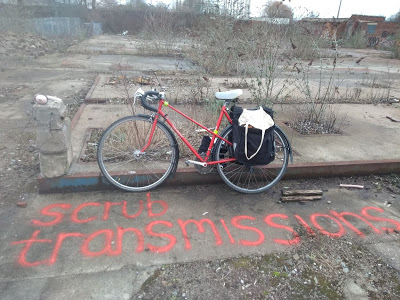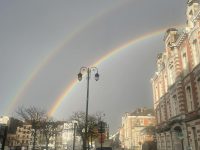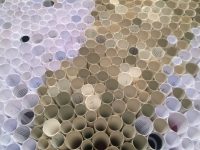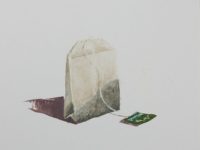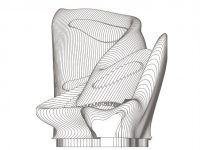Transmitting the outskirts of the city: LoneLady’s Scrub Transmissions
It’s often too easy to conflate place with music, and vice versa. It’s tempting to view a city through a lens of its cultural production, to hold on to a static image of past achievements and overlook the ways in which places, and their culture, continue to evolve. It’s also easy to reduce an artist to their urban identity, to limit them to an artistic lineage that is geographically – and therefore to some extent always arbitrarily – defined.
There is a sense of LoneLady trying to break out of these boxes, to get away from a very particular – and often male – Mancunian identity. Yet at the same time, her music is undeniably shaped by Manchester. It’s the place where she grew up, on the eastern fringes of the city. It’s also the place in which her two albums to date were written, rehearsed and recorded, in largely self-built rehearsal and studio spaces in former industrial units in isolated areas outside of the city centre. Until recent acquisitions by developers capitalising on Manchester’s property boom, these places, surrounded by half-demolished buildings, light industrial activity or red light districts, were available and affordable to artists due to their relative geographical and cultural remoteness. Despite their uncertainty of tenure, artists became used to coexisting with damp, mould, cold and mice, fashioning and reinventing these spaces to fit their needs and finding the space and freedom for invention and experimentation amidst physical decrepitude. These were the places where most of Manchester’s real creative work was done.
LoneLady both acknowledges this geographical specificity in her work and attempts to break away from it; most recently, she’s stretched her wings with a long-term residency at Somerset House in London. As a Mancunian woman, she sees herself not just as struggling for visibility within the mainstream music world, but also as an outsider to the city itself. She situates herself both physically and metaphorically on the edges of Manchester, and outside of the myths manufactured by those who wish to shape our perceptions of it.
LoneLady wants us to share and understand the mundane places and subtle experiences which influence her sensations of the city day-to-day, and our place within it, as a place that is lived in, worked in and travelled through, and as a city that – far from the promotional spiel of business, tourism, redevelopment and economic growth – continues to be uncertain, often difficult and sometimes unwelcoming for those who exist outside of its dominant uses and narratives.
Far from the shininess and spectacle of city centre redevelopment, LoneLady tries to tell us different stories, to show us other cultural landmarks. In 2012, she invited us to plug our headphones in and experience her music in the context of 1960s elevated motorway the Mancunian Way, through her temporary installation The Utilitarian Poetic, which embedded a previously unreleased track beneath a flyover on the outskirts of the city centre. TUP drew our attention to a structure that is both a permanent presence in the city, yet which is almost always experienced in transit, and a place where few stop to linger. Removing fast-flowing traffic from the city’s roads, the Mancunian Way flyover distances motorists from the city at ground level, yet it also creates a constant background hum for those who live and work in the estates and buildings alongside it.
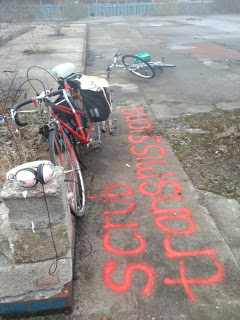
Six years later, LoneLady again asks us to turn our back onto the city centre and to venture east to the inner-city neighbourhood of Miles Platting, an area that borders Clayton on one side and Ancoats on the other, on the banks of the Ashton Canal. East Manchester, a former industrial and mining district, where Clayton is situated, remains one of the poorest areas of Manchester, despite the new sporting facilities built during the Commonwealth Games in 2001. By contrast, Ancoats, which borders the hip Northern Quarter area of Manchester city centre, has, in just a few years, become unrecognisable. As derelict former factories and mills have been converted, alongside new-build flats, a previously under-visited area of the city has been filled with bars, shops and restaurants catering to young professionals, and is regularly featured in local and national media as a ‘foodie destination’.
Apartment blocks are gradually encroaching further into east Manchester, capitalising on the improved access to the city brought by the building of the East Manchester tram line. However, despite its proximity to Ancoats and Manchester city centre, Miles Platting feels like a different world entirely. Here, we see and hear different uses for the city, which don’t fit comfortably elsewhere: families gather in special dress in small sections of industrial units repurposed as places of worship; graffiti artists find ample space to exhibit their work. There’s also evidence of others left behind by the city’s redevelopment, including rough sleeping and heroin use, on wasteland exposed by the demolition of former industrial buildings.
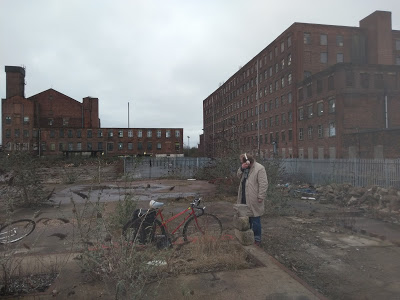
There’s also a sense of openness here, of a place that is yet to be rediscovered and rebuilt. Into this left-behind landscape, embedded in a tower of rubble, LoneLady has inserted ‘Little Fugue’, an unreleased track from 2014. Behind you are gas towers. In front and to the side are patched up industrial buildings, some missing windows, and subdivided for a variety of commercial and creative uses. In the background, plodding indie rocks competes across the canal with band practice emanating from a facing building. Through the headphones, LoneLady’s guitar chimes gothically over a synthy, dancy track that both suggests something of her city’s heritage, but shows it is possible to do something new with it.
Then we hear a voiceover, a story about what this area has meant to her. It concludes by urging us to: “Hear the voices of the landscape, before they’re scrubbed out.”
Scrub Transmissions went live on Sunday 18 February and continues until the battery runs out (duration dependent on weather conditions!). For map and further information, visit http://lonelady.co.uk/blog/scrub-transmissions-miles-platting.

An accompanying ‘zine by LoneLady is available from the Peer Hat and Piccadilly Records, costing £3.
Notes(And links) from Editor
More About Lonelady, (from Wikipedia):
Julie Campbell, known as LoneLady, is a solo artist from Manchester, England. Her music is influenced by the post-punk era, later integrating dance and funk influences. She first started making music on a 4-track cassette recorder in her tower block flat in Manchester while completing a Fine Art degree. LoneLady’s stark, early first gigs featured Campbell alone playing electric guitar along to a drum machine. This would later evolve to a 4-piece band live.
Campbell came to the attention of Warp signing with them in 2009, and her first album Nerve Up was released in 2010 to widespread critical acclaim. The NME called it a «unique, brilliant debut … we should celebrate LoneLady as the arrival of a fresh and invigorating voice whose talent transcends time and space and influence» and it also drew praise from music journalist Paul Morley.
Campbell’s music is characterised by a lo-fi, economical approach; she has said that «Working with basic tools, mainly an 8-track cassette recorder, a telecaster and a drum machine forced me to be economical and inventive, and set an aesthetic blueprint for the way I like to work, to keep things stark and urgent.»
Inspired by psychogeography, with dance and funk influences coming to the fore, Campbell’s second album Hinterland was released to widespread critical acclaim in 2015. The Quietus called it a «vibrant and urgent combination of genealogy and vision – and it is this that truly makes it a masterpiece.» All four singles released from Hinterland reached the ‘A’ Playlist on BBC 6 Music and Campbell also received a Sky Arts nomination for Best Breakthrough Artist.
3,303 total views, 1 views today

